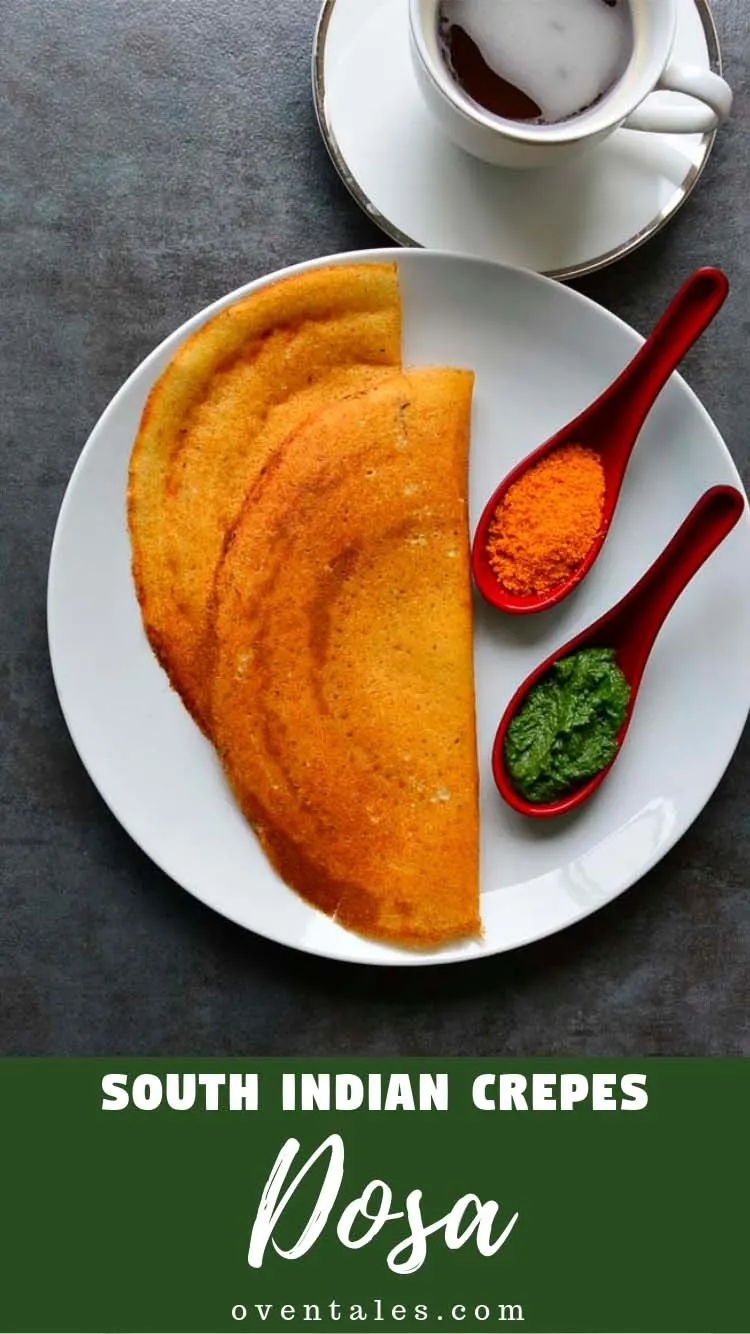Dosa is by far the most popular South Indian Dish. This is a healthy crepe made with a naturally fermented rice and lentil batter. These are so popular that, many households have a a container of Dosa batter in the fridge all the time. There are many variations of the basic recipe , but today it is all about the ever popular classic Plain Dosa . 
Moms love it as an easy on demand snack that can be made and served anytime. Serve with a quick chutney for an easy nutritious snack or with assorted chutneys, fillings and sides for a more substantial meal. Think about this you have a container of dosa batter ready to go. 5 minutes is all it takes to make fresh, piping hot dosas . Serve with a quick chutney powder (like the flax seed chutney powder ) – and you have a protein filled nutritious snack/meal. There are no preservatives, fillers or any artificial ingredients here. Any wonder there is almost always a container of dosa batter in south Indian homes ?
Compared to many other bread and pancake recipes dosa is a very forgiving. A wide varieties of rice to dal ratios yield excellent results. Where as idlis, the steamed cakes made with a very similar batter, are quite another story. 1: 2 to 1:5 ratio of urad dal to rice works well. Increasing urad dal to rice ratio to 1:1 or more will yield very soft and spongy dosas that tend to stick to the pan or break as you remove them from the pan . Too high a percentage of rice will tend to weigh down the batter, and will not yield the characteristic spongy texture or flavor of traditional dosa. But with enough fermentation a rice heavy batter could make pancakes similar to Appams.
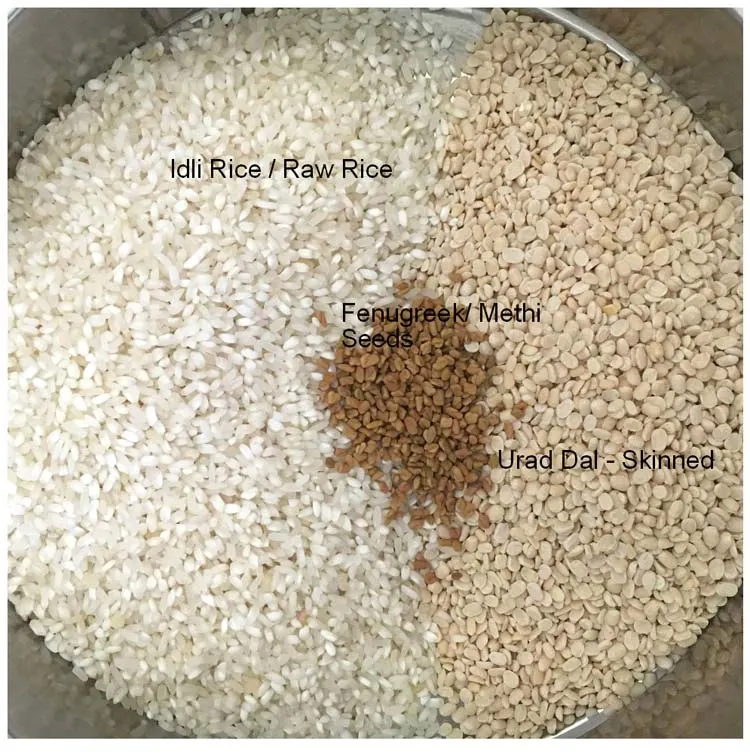
Here are the basic ingredients for the dosa batter – Rice and Urad dal and optionally some methi (fenugreek) seeds. The way I understand it – methi seeds are used to kick start fermentation, as a wild yeast starter. The fermentation involves a many naturally occurring yeast and bacterial strains. Modern processing methods tend to strip the rice and grains of these. This is where the seeds comes in as a starter. If you were using whole unprocessed ingredients- say unpolished rice , or whole dal with skin on – there is no need for fenugreek seeds.
When you start out making your dosas I would suggest trying the 1:3 ratio of urad dal to rice . If you can find Idli rice , use that, but most raw /parboiled rice will give good results . As you get more comfortable with the grinding and the fermentation of the batter , you could experiment with altering the rations and different types of rices.
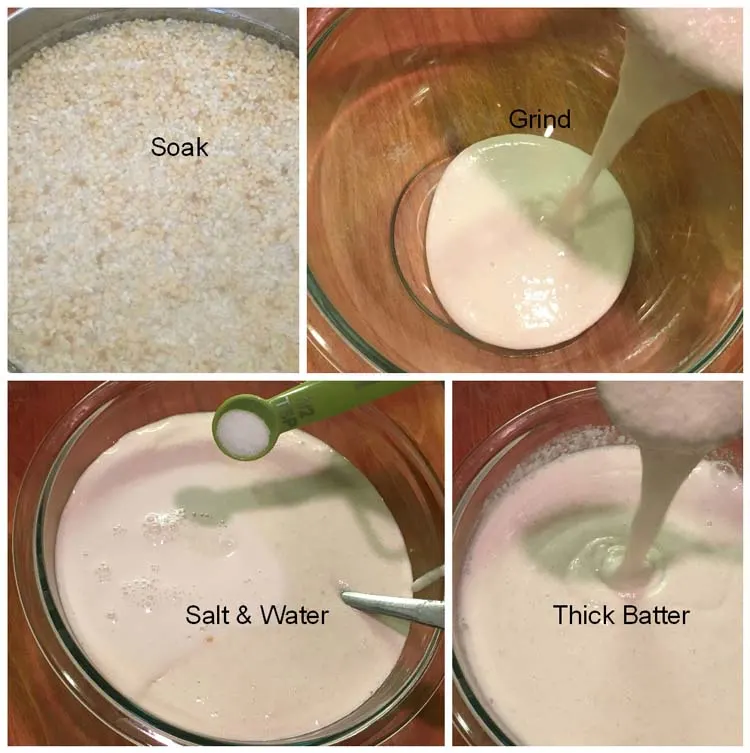
Wash and soak the rice and urad dal in plenty of water. For dosa batter you can mix both and soak together. You need a good quality grinder to grind these. The blenders and grinders used in Indian homes are usually usually of 500 or more watts and will be up to the job.
The rice and dal need to be soaked for at least 3 hours. Drain from the water and grind to a smooth paste. As you start grinding add just a tablespoon of water or so. As the grains break down drizzle water little by little , just enough to keep things moving. If your grinder/blender seems to heat up during the course of grinding, stop and wait for everything to cool down, add a little more water to the mix .
It is important to keep the batter from getting hot. If needed work in multiple batches.
Pour the batter into a pan large enough to contain at least twice the amount of batter . Mix in the salt and add just enough water to make a thick a batter. Cover and set aside for 10 to 12 hours under warm conditions. In warmer weather the batter ferments in as less as 4 hours. If that is the case check the batter after 2 hours. If there are signs of vigorous fermentation, transfer to the refrigerator and keep chilled until about 30 minutes before cooking.
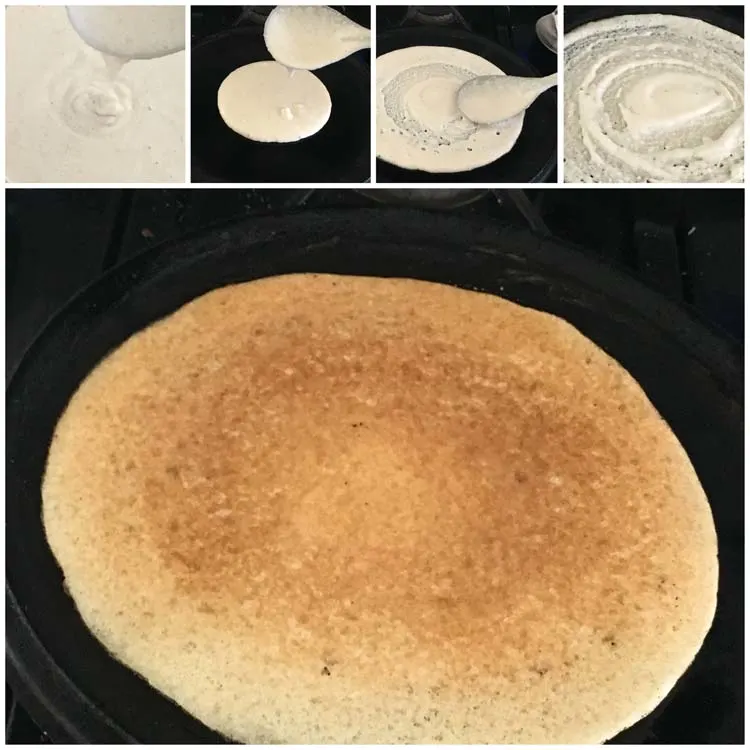
When ready to make dosa, heat a griddle or a thick bottomed pan (tawa) over medium heat. personally I prefer the cast iron griddles (the traditional choice) over the non stick pans. These retain and heat evenly without creating a hot spots and make perfectly crisp dosas. Cast iron pans are my tools of choice whether I am making dosas, fluffy pancakes, eggs or rotis.
The batter would have risen fairly well by now. You should be able to see a slight dome on the to . Get the ladle all the way to the bottom and turn to mix the batter from top to bottom . There should be plenty of tiny bubbles inside. The heavier rice particles tend to settle in the bottom and the more lighter urad tends to get carried up to the top by the co2 molecules. Give it a good mix to get a homogeneous mixture. Fill the ladle and tip it to pour the batter back in. It should flow down in a thick stream and not fall as a big blob. If needed add a few table spoons of water and mix well until a thick pouring consistency is reached. This is a good time to taste and adjust salt as well.
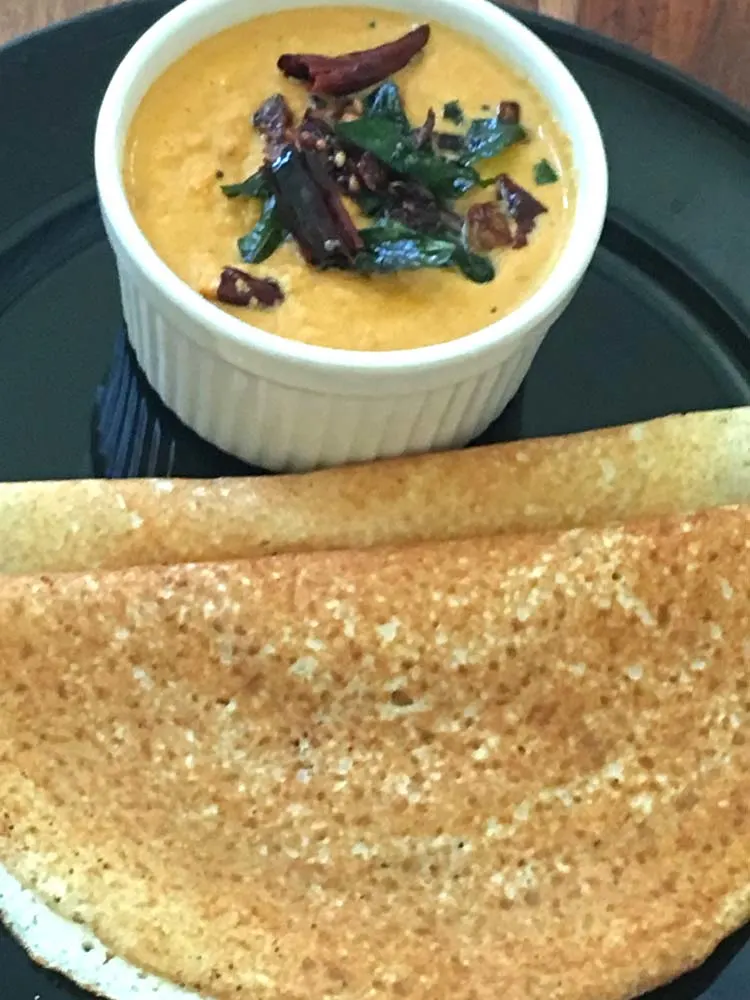
Here is dosa with Kerala Style Coconut chutney.
When the griddle is hot lightly brush the top with oil. It should be evenly coated with oil, with no pools of oil on the surface. Pour one or two scoops of batter in the center of the pan , (depending on the size of your griddle and the scoop) and spread using the back of the ladle in a spiral motion from center to the outer edges. This creates a thin disc with a few thick circular ridges. This is the traditional pattern for Dosa. This creates a few softer regions preventing it from breaking apart when transferred from the pan.
Cook for 30 seconds or so till you begin to see the thinner portions turning golden brown . Pour few drops of oil on top and around the sides. The oil on the sides will help release the dosa from griddle. At this point , you have a choice to either flip and cook on the other side or let it cook through in the same side. If you choose not to flip make sure that the heat is set on medium , so as not to let the bottom burn .
As the sides begin to brown and seems to pull away from the griddle use a turner to flip the dosa and let it cook for another 30 seconds . Transfer to a serving plate . Serve hot.
The recipe for the most traditional basic dosa is as follows.
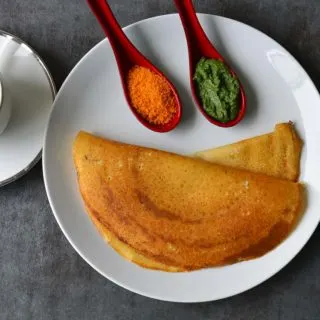
Plain Dosa
Ingredients
- 1 1/2 C Raw Rice
- 1/2 C Urad dal Skinned
- 3/4 Tsp Salt As needed
- 1/2 Tsp Fenugreek /Methi Seeds (Optional)
- Water - As needed
- Oil - As Needed To cook
Instructions
- Wash and soak the urad dal , rice (and fenugreek seeds) separately in plenty of water for at least 3 hours.
- Drain and grind the urad dal fine with just enough water to make a fine fluffy batter.
- Transfer to a large container .
- Drain the rice and grind smooth by adding just enough water to make a fine paste. Transfer to the container with the urad dal batter.
- Add enough salt and a little water to mix the rice and urad dal pastes well together. Cover and set aside in a warm place to ferment overnight (8 to 10 hours under normal temperature).
- Uncover mix well. Mix in a few tablespoons of water to make the batter into pouring consistency. Taste and adjust salt if needed .
- Heat a tawa or flat griddle . When hot lightly brush the top with oil . Wipe of excess oil .
- Pour a ladle of dosa batter at the center of the hot tawa. Spread the batter thin using the back of the ladle in circular motions.
- Cook for 30 seconds or so till the sides begin to turn brown. Brush or sprinkle a few drops of oil on and around the edges of the dosa. Use a flat spatula or turner to flip the dosa . Cook for 20 to 30 more seconds and remove to a serving dish ,
- Repeat with the remaining batter,
- Serve hot with assorted chutneys , sambar or your favorite side dish .
Notes
- You could soak the rice and dal together and grind together if the blender/grinder is powerful enough.
Important: Nutrition Values are estimates. Actuals vary based on ingredients and serving size.
Notes:
- If unsure of the grinder’s power , soak rice and dal separately, and grind in small batches.
- When soaking separately you can add the fenugreek seeds to either batch.
- Once fermented keep the batter in fridge and take out only the amount needed to mix with water and salt.
- Over fermented batter can be used to make oothappams, which are thicker pancakes with spices and herbs mixed in .
- If the batter sticks to pan make sure that it is oiled properly .
- A well seasoned pan needs to brushed with oil only in the beginning and after every few dosas.
- If the batter is too thin, it tends to stick more and will take longer to cook .
- In cold weather, keep the batter in the over with the light on , or in an insulated box with a hot pack by the side.
Dosa is served with assorted chutneys or podi (chutney powder). But these a good way to scoop up many of the curries though south Indian prefer their coconut chutney or sambar .
